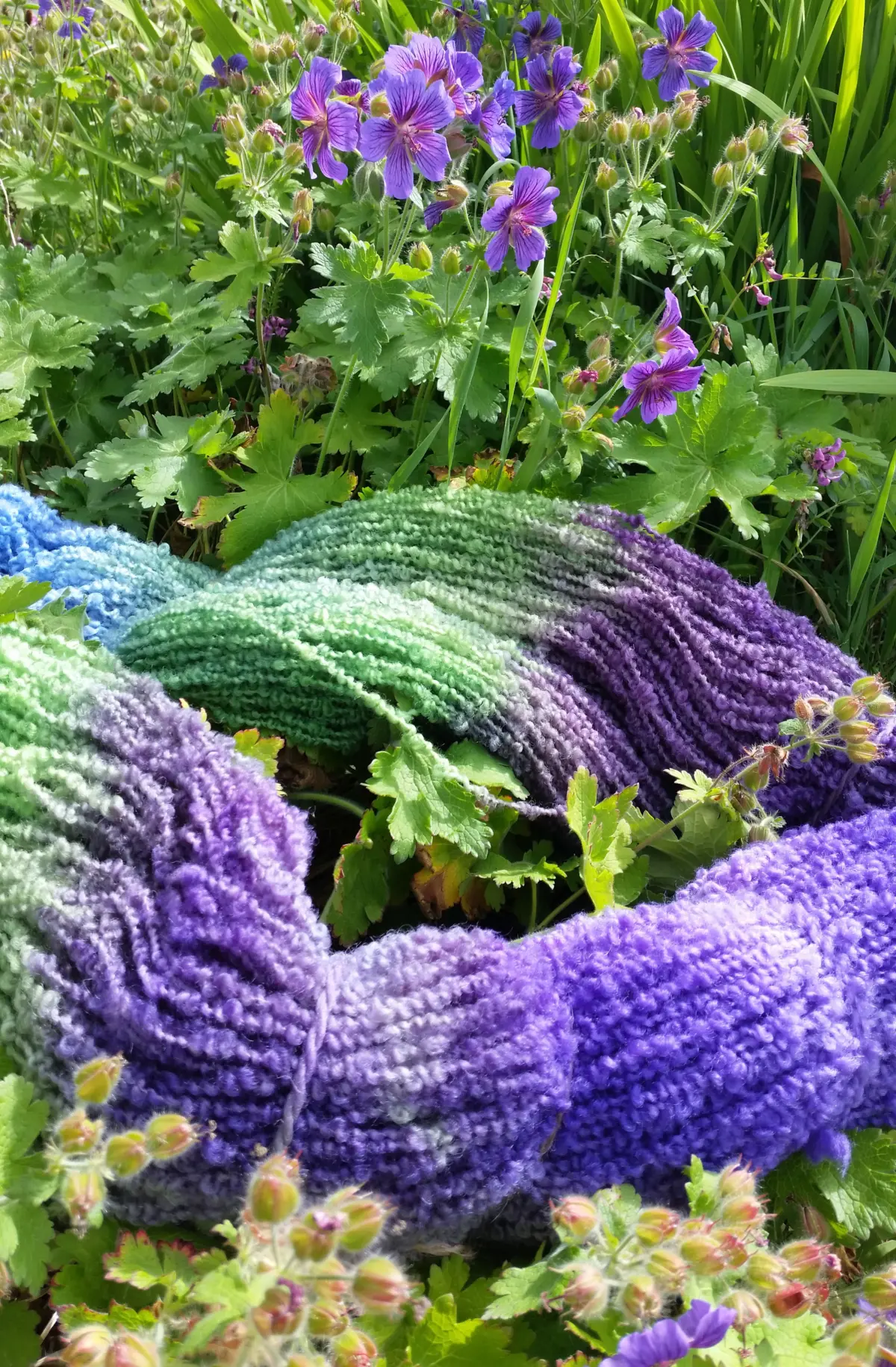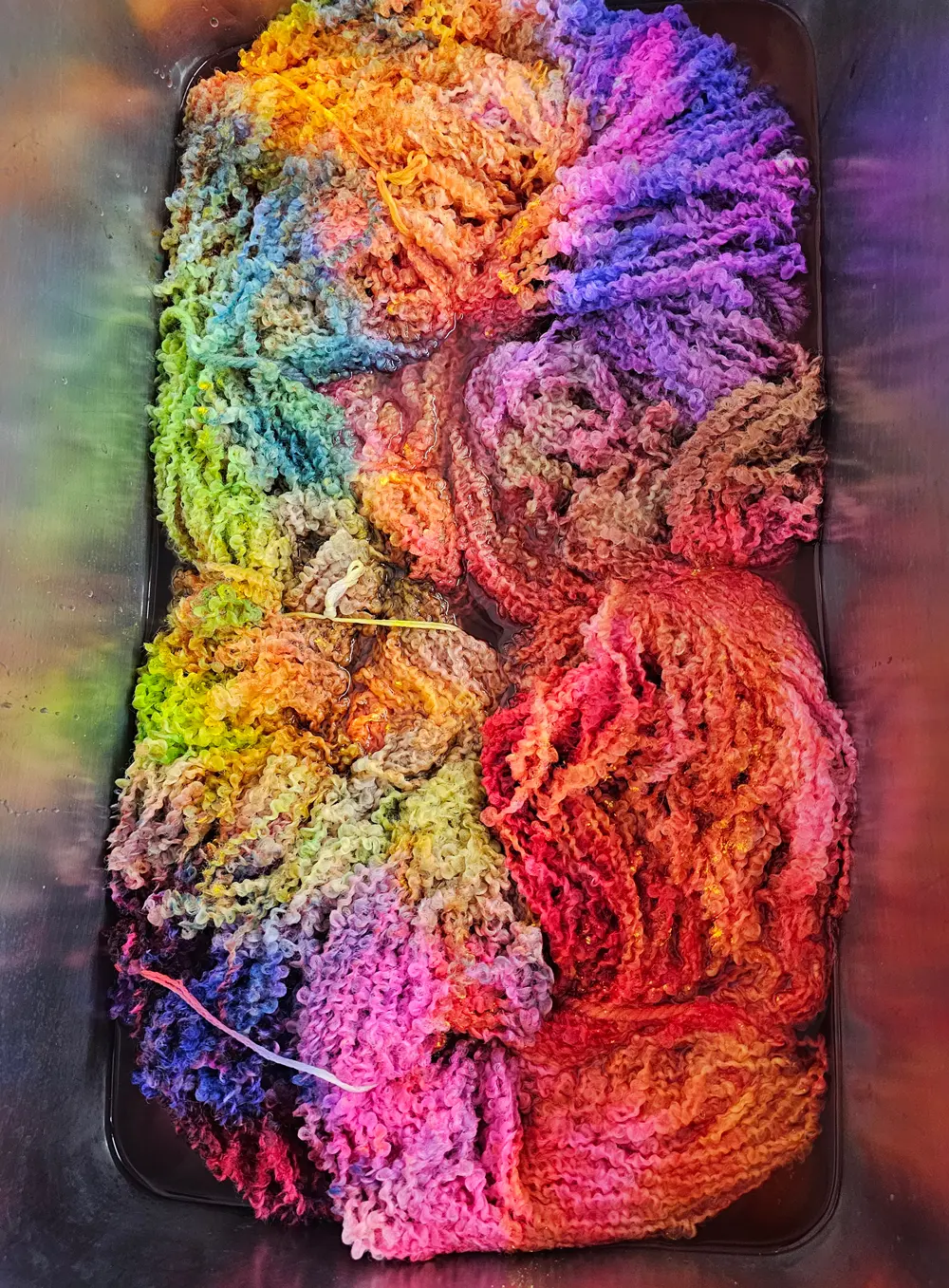Your cart is currently empty!

Understanding Yarn
Liz Christy
There is a plethora of information out there to describe what yarn is. There is endless detail on the technical stuff, the best yarn for weaving, the way it is measured, where it comes from, types of yarn and whether it is a protein or a cellulose fibre, when it was first spun, and how the production of it impacted farming, industrialisation, and the day-to-day lives of the people who were involved in the making of it.
Understanding yarn as a professional weaver
So what does yarn mean to me as a textile designer and artisanal hand-weaver of luxury scarves?
As a textile designer, I enjoy the spontaneous nature of hand-weaving. Sometimes yarns sitting on a shelf for a while will wink out and say, “Pick me!”. What a great joy it is to bring them to life. Such a piece will never be duplicated. The lucky recipient will wear a piece of time, lovingly captured in woven threads.
I must admit that it is all about the feel of a yarn and whether it will find a place on the shelves of my studios or not. Regarding specific types of yarn, I generally work with cotton, wool, silk, kid mohair and alpaca. In the pre-Internet days of the 1980s, finding yarn suppliers involved me travelling on the bus to Dublin to spend time in a business library, trawling through information to find names and addresses of yarn suppliers. Letters were hand-written and posted, followed by much waiting for responses and samples.
Of course, the internet is at our fingertips today, and travelling to European yarn shows is possible, making it much easier to understand yarn. And no matter how beautiful the yarn is, the business question is, are they willing to supply me with quantities of yarn that are feasible for me to buy? What is their stock colour range, their minimum order per colour, and at what price?
From the early days of my hand-weaving business, my signature style evolved from a few elements that have remained constant. I enjoy working with colour and cotton, and I like stepping away from what’s considered the “best yarn for weaving.” I also like combining fibres that are not traditionally combined.
How do Different Types of Yarn Impact the Result
Why do I generally use a mercerised cotton warp? The answer is simply because I like how it gives a beautiful drape to a scarf. My supplier has a wonderful shade card and sells it to me in small quantities of their many colours. It is fine, vibrant and has a beautiful sheen. This enables me to design my Monet-inspired warps, which have become a staple of the Liz Christy brand over the years.
Many years ago, as a college student, I enjoyed dyeing wool, particularly dip dyeing and the random effect it gave me. I found a wonderful small-batch hand dyer in Wales. Her colours were fabulous, and her boucle yarn worked perfectly with my warps. I bought from her for a long time until she retired.
It took a while, but I found the yarn spinner factory in England that had supplied her with her base undyed wool, and I have since been buying my boucle wool from them by the 300kg load, which they custom spin for me. I gathered up my pots and my dyeing supplies and embarked on what has become a favourite part of my business: hand-dyeing my wool. In the same way, I look for inspiration when I set out to work up a new scarf design, and I also look for inspiration for the yarn I dye. I find it in nature and the changes in our drumlin landscape through the seasons. Indeed, some of it is Monet-inspired, but the collector in me gathers up things I like, especially colourful things. The rare magazine purchase in our house results in pages torn out and bits and pieces being pasted safely into my colour inspiration scrapbook.
Unlike the fashion trends in magazines, my colour scrapbook is timeless. If the colours danced together in 2014, they will continue to dance. Setting out on a day of dyeing, intent on working on one colour, say green, is something that I find difficult. I must let it evolve and may end up dyeing anything but green. Not that I have anything against dyeing green!
Where Green Meets Purple: Colours of Harmony
Green and purple are where my soul feels most at home. There is something about the meeting of these two colours that speaks to me deeply—green with its grounding connection to the earth and the Irish landscape, and purple with its sense of richness, imagination, and quiet mystery. When they come together in a scarf design, I find a harmony that is both soothing and uplifting. Perhaps it’s no surprise, then, that these combinations not only delight me personally but also resonate strongly with others, becoming enduring favourites and best sellers.
I see this most clearly in designs such as Waterlilies – Wild Lupin and Argenteuil – Lavender Dreams. Each piece draws from nature and art: the rippling greens and violets of wildflowers along a summer lane, or the shifting tones of Monet’s gardens, where light and colour seemed to dance endlessly on canvas. When woven into cloth, these hues invite you to wrap yourself in something more than colour.
For me, these scarves are more than accessories; they are the closest reflection of my creative spirit. And for those who wear them, they seem to carry that same energy: a balance of grounding, calm and vibrant expression, captured in threads of green and purple.

I have built up a recipe book of dyes over the years. Even though I use a recipe, every hank of wool is unique, simply because it is done by hand, which means there will never be two identical Waterlillies – Wild Lupin scarves. Of course, sometimes there are hanks of wool dyed without looking at a recipe; they evolve serendipitously and are never to be repeated! Often, we use these beauties for our LizzyC Sheep, giving all those little characters their personalities.
The hand-dyeing of the weft wool is a process I undertake on the opposite side of the workshop floor, where I have my dye area set up. When hand-dyed yarns are added into the mix, serendipity happens on the loom and gives us great joy as we weave and see how the yarns and colours shimmer as they are woven together. Understanding yarn properties as I do, it’s still a process that never gets old, weaving with our hand-dyed wool continually affords us lovely surprises, like painting with thread.

The Joy of Colour
Recently, I have been exploring a new hand-dyeing technique—one that feels freer, more playful, and full of delightful surprises. Instead of my traditional approach, I now pour, sprinkle, and squeeze colour directly onto the yarn. This looser, more instinctive method allows the dyes to mingle in unexpected ways, creating patterns that are both vibrant and subtle, dramatic yet delicate. No two results are ever alike, and that is exactly what makes the process so exhilarating.
There is a joy in the dyeing itself, but also a wonderful sense of anticipation. Once the yarn is dry, the next question is how it will behave on the loom. Which warp will set off its tones best? How will those scattered flecks of colour transform once they are woven into cloth? Each stage feels like unwrapping a gift, full of discovery.
From this spirit of experimentation came our newest creations—the Dappled Scarves. Each one is truly one-of-a-kind, with shifting hues that echo sunlight through leaves, shadows on water, or wildflowers scattered across a meadow. They are alive with movement and energy, capturing the spontaneity of the dyeing process and turning it into something wearable, personal, and timeless.
The Best Yarn for Weaving
I am often asked what the best yarn for weaving is and whether I use Irish wool. The answer is that I use wool spun in Ireland by Donegal Yarns in Kilcar. Their lovely Aran Tweed (a blend of Irish and New Zealand wool) is my weft of choice, woven with fine mercerised cotton warps in our Kavanagh Collection. I love their shade card, and when I need something other than what’s on it, I use their undyed ecru and work my magic.
Donegal Soft Merino wool is pure luxury when woven with silk for our elegant lace-weave Renaissance wraps. Why did I combine these types of yarn? I knew instinctively that they would work well together for the lightweight wrap I had in mind, one that would drape elegantly yet have the cosy warmth of merino wool.
So, what is yarn to me? I know it when I hold it in my hands. It is the beginning, the middle and the end of every working day in some way, shape or form, and if it feels right to the touch, then it’s right.

